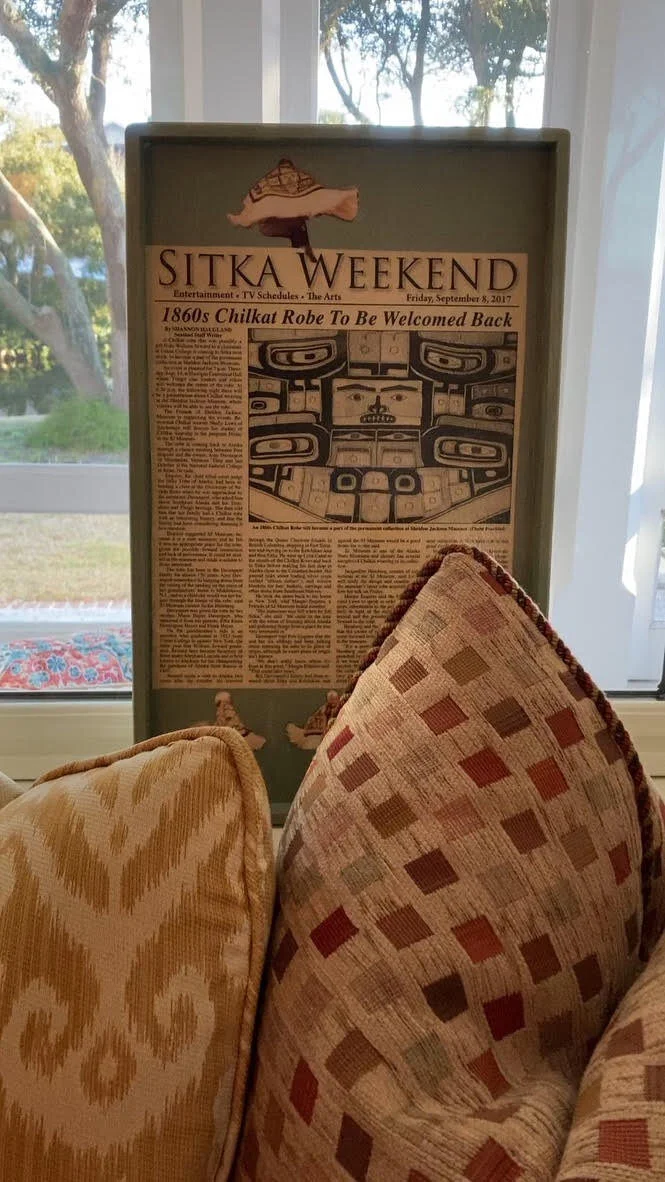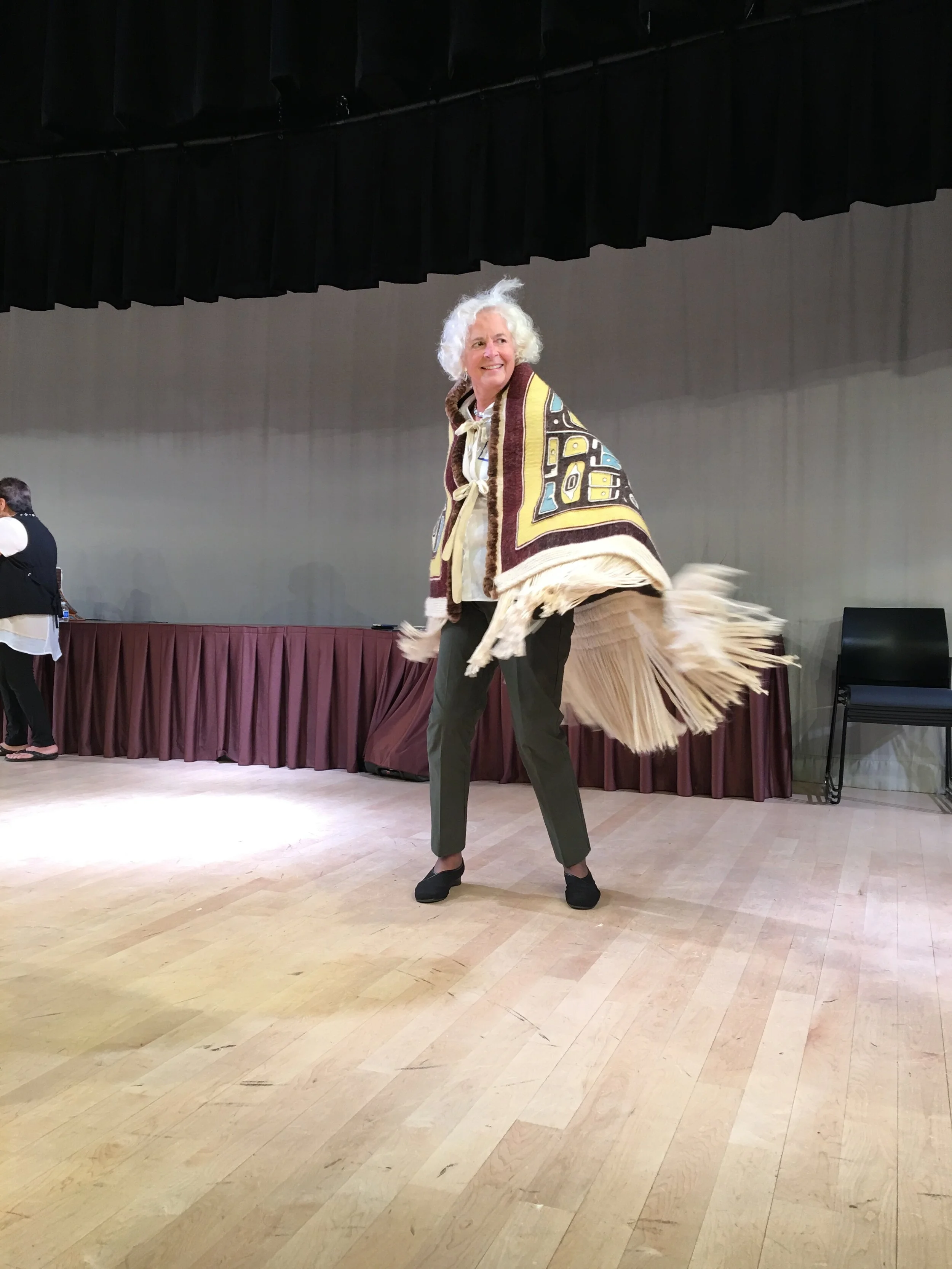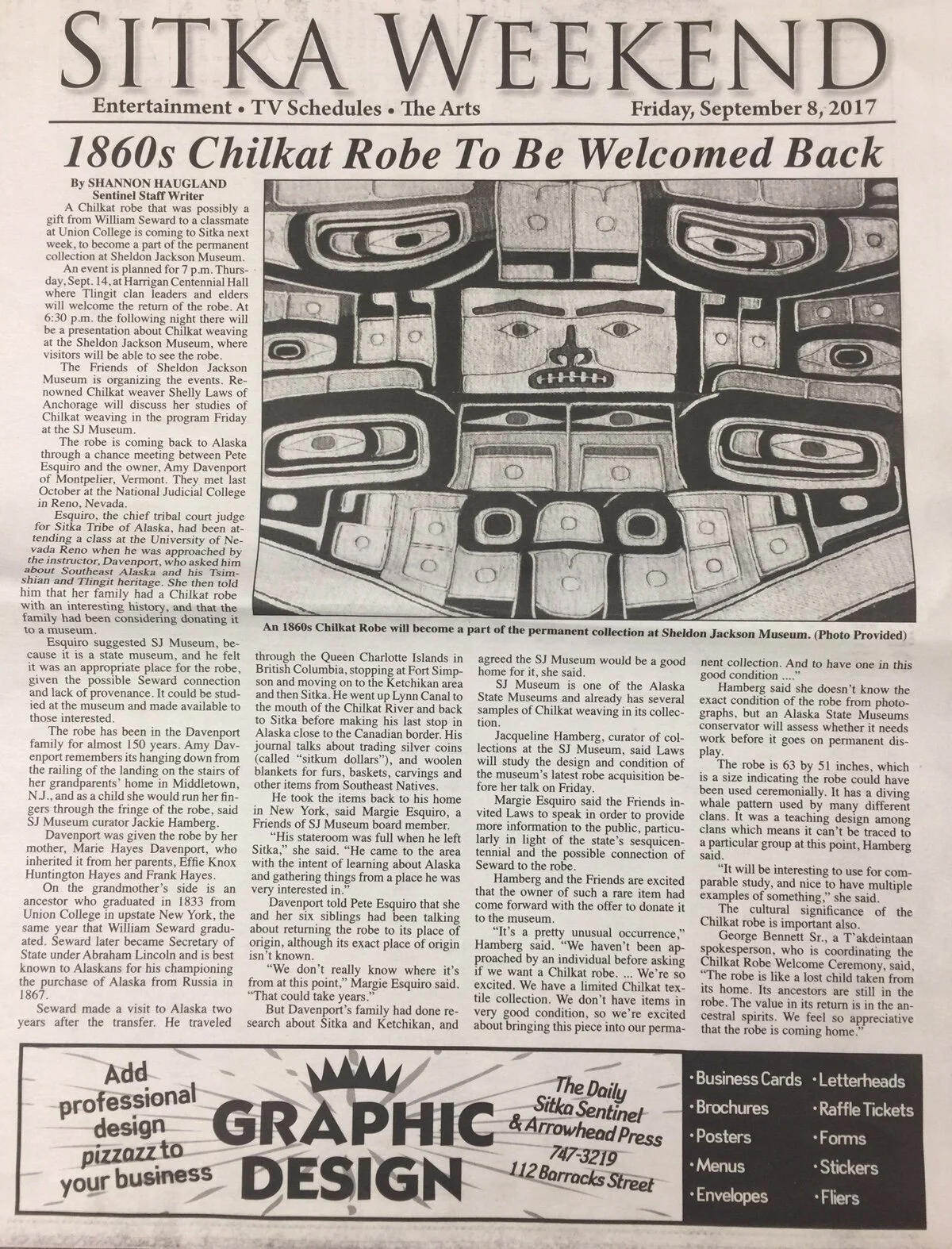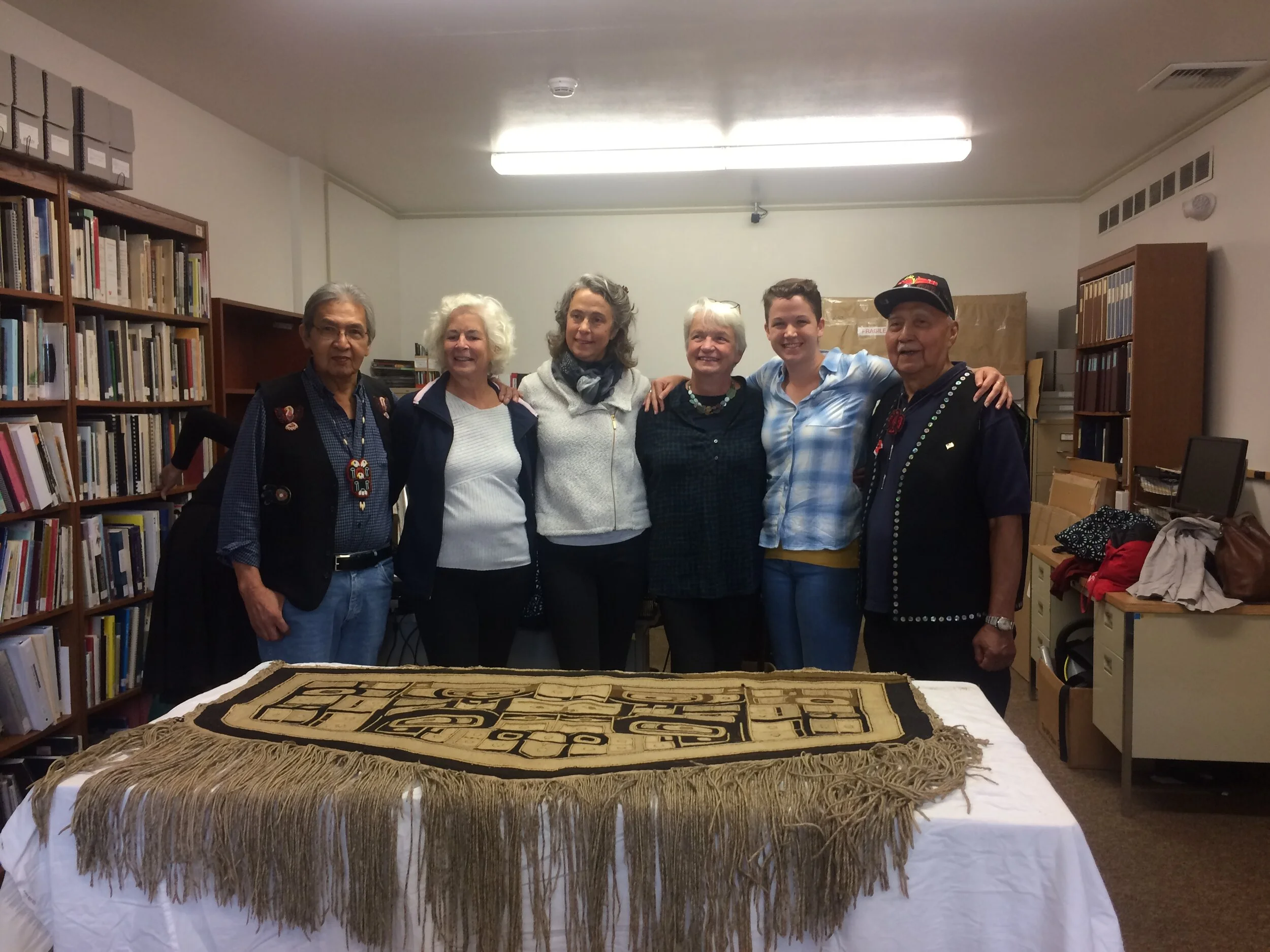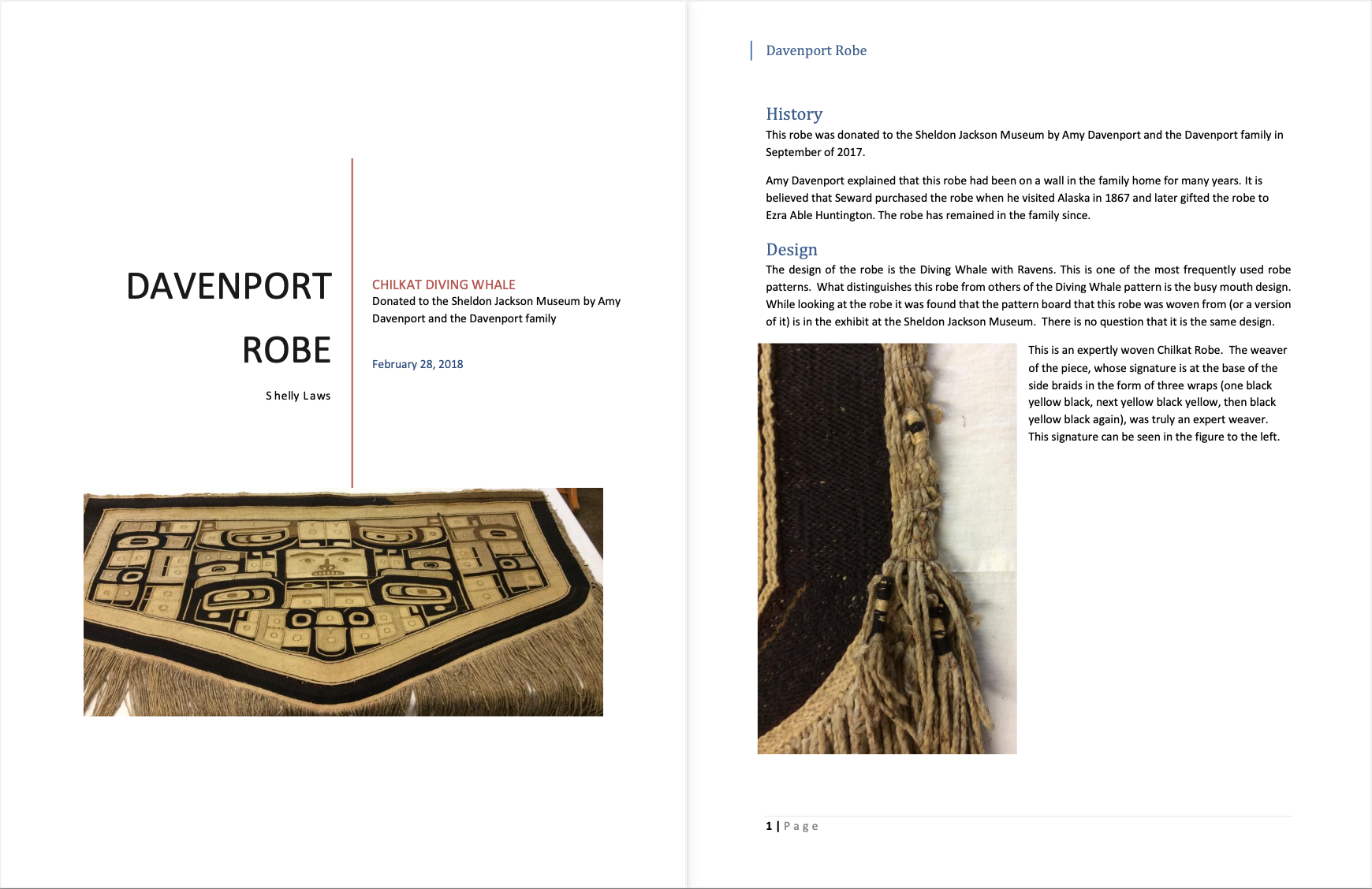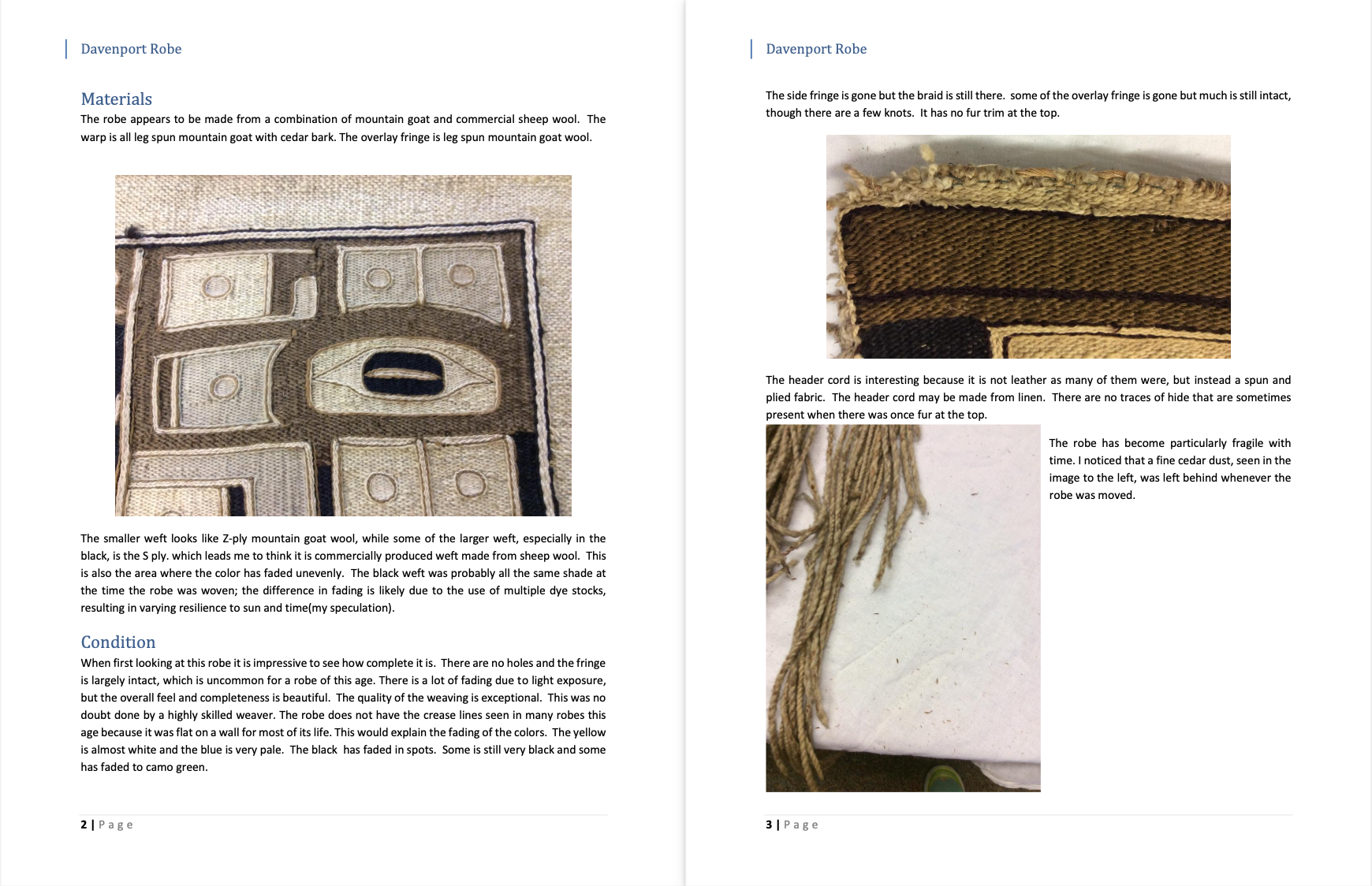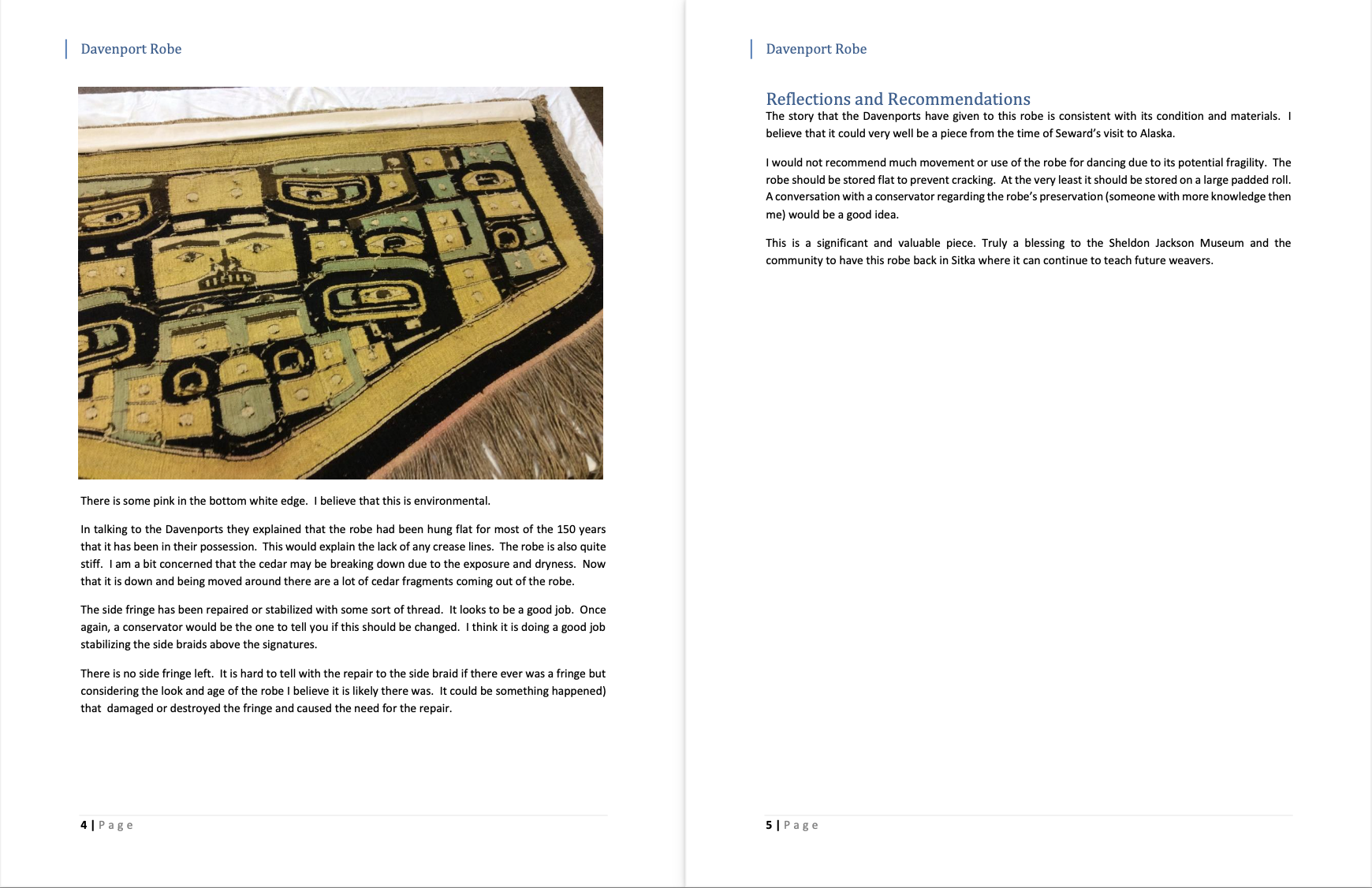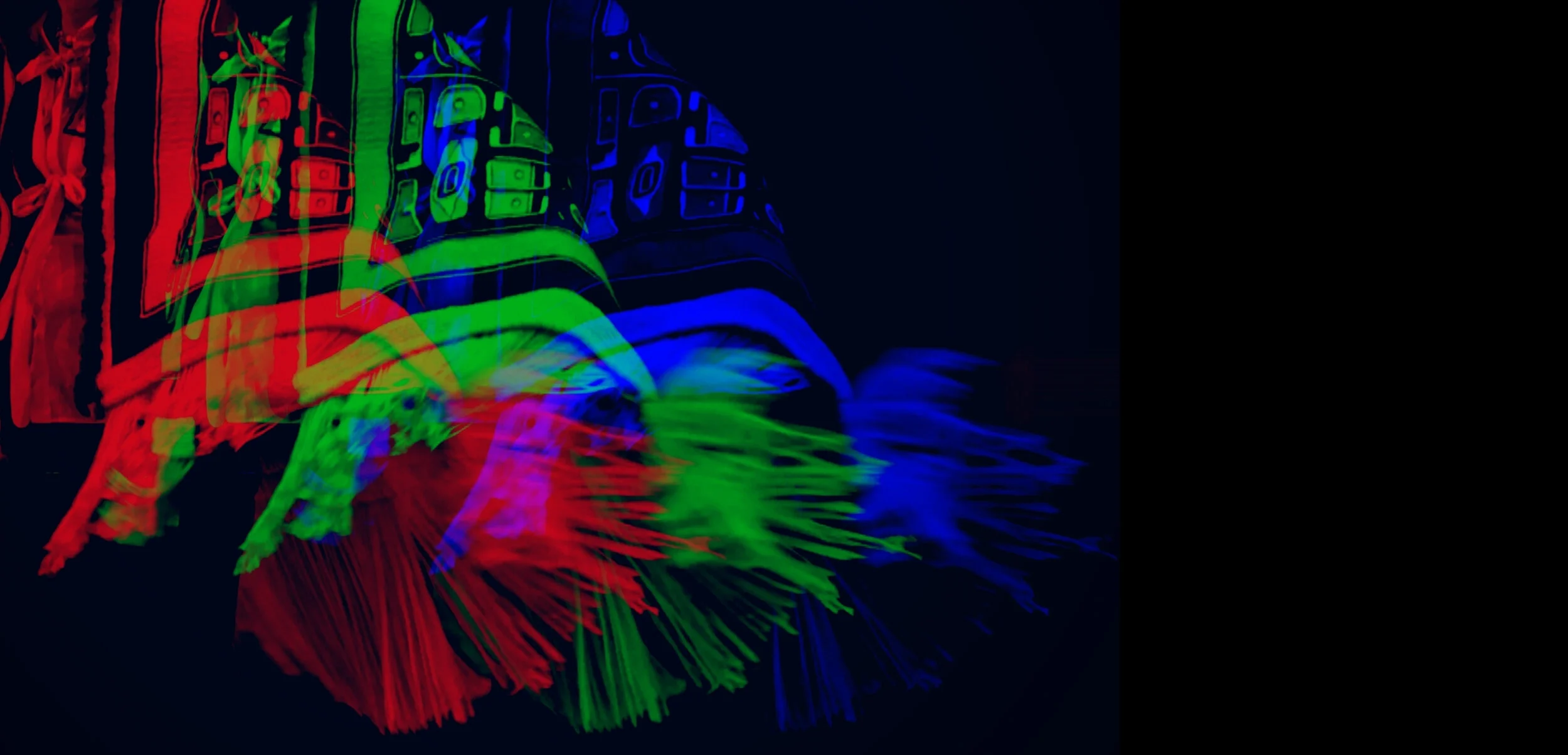
The Chilkat Robe
The Chilkat Robe was a family treasure for close to 150 years. In 2017, Amy Davenport (with other Davenport sisters and family in tow) returned the Robe to its family of origin- The Sitka Tribe in Alaska. The homecoming story of the robe is poignant, lovely, and a profound testament to the power of objects to become generational subjects for an ancestry of narratives.
A History of the Davenport Chilkat Robe
The Chilkat Robe, donated to the Sheldon Jackson Museum in September of 2017, was a family treasure for close to 150 years. My earliest memories of the Chilkat date back to my childhood. Although my parents lived in New York City, my grandparents on my mother’s side owned a lovely home in Middletown, New Jersey, where I, along with my six siblings, spent all of our summers and many weekends during the school year. The Chilkat was very much a part of our childhood.
In this document, I attempt to trace the history of the Chilkat Rove from the time it traveled from Alaska to the East Coast in the 1860s until its return to Sitka in 2017. I acknowledge that it is a history that has some holes in it. Looking back, there are so many questions that I wish I had asked my grandmother or my mother while they were still alive. I have taken what my grandmother did tell me, however, and combined it with what I know from genealogy charts, historical facts about William Seward and my great-great grandfather, Ezra Abel Huntington, and letters provided to me by the archivist at Seward House in Auburn, to construct what I believe to be the most probable stages of its round-trip journey and the homes in which it lived.
The Journey from Sitka, Alaska, to Auburn, New York
My grandmother was born in 1888. Her name was Effie Knox Huntington. Her father was Samuel Van Vechten Huntington who was the son of Ezra Abel Huntington. According to my grandmother, the Chilkat was given to her family by William Seward who, as Secretary of State, negotiated the purchase of Alaska in 1867. Two years after the purchase, Seward visited Sitka and returned home with many gifts from the Native American peoples who lived there – namely the Tlingit and Tsimshian tribes. I believe that the Chilkat my siblings and I grew up with was one of the gifts he received in Sitka and brought back to his home in Auburn, New York.
How the Chilkat subsequently came into my family’s possession is somewhat of a mystery since we have no written document that memorializes its provenance. We do know, however, that for a good portion of his life, my great grandfather, Ezra Abel Huntington, lived in William Seward’s hometown of Auburn, New York. Ezra was a Presbyterian minister. In 1855, he accepted a professorship at the Union Seminary in Auburn and moved there with his family. He remained in Auburn until his death in 1901. Seward moved back to Auburn in 1869 when his role as Secretary of State came to an end with the election of President Grant. The gift of the Robe from Seward to my grandfather would have taken place between 1869 when Seward returned from his visit to Sitka and Seward’s death in 1872.
I know of one letter between Ezra and Seward that is included as an Appendix to this memo and appears to have been their first exchange. It predates the Alaska purchase and Seward’s trip to Sitka by six years. On Dec 18, 1863, Ezra wrote to Seward to thank him for the donation of five volumes of “diplomatic correspondence” to the Union Theological Seminary. It is clear from the letter that the two men had yet to meet, but the letter is highly complementary of Seward’s role as Secretary of State. It ends with the following paragraph:
“Though never a politician, yet am since you became a young Governor, when I was a younger pastor, in Albany with due interest, and almost invariably – I remember no important exception – in full sympathy with your views & opinions.”
Ezra wrote Seward again in 1869 to thank him for the gift of about a hundred books to the Seminary’s library, but there is no mention of the Chilkat or Seward’s trip to Sitka. If there are other letters, they have not yet come to light. Any letters my grandmother would have had were burned when the home in Middletown caught fire sometime in the late 1960s or early 70s. Fortunately, the Chilkat survived that fire. Sadly, the letters in the attic did not.
The Journey from Auburn, New York to Middletown, New Jersey
My great grandfather, Samuel Van Vechten Huntington, was born in 1852 and died in 1939. In 1887, Samuel moved to New York City and married Marie Robertina Van Vechten. I do not know if the Chilkat graced Samuel and Marie’s home in New York City where my grandmother was raised as an only child. Eventually, however, Samuel and Marie moved to Middletown, New Jersey, and presumably lived with my grandparents until they died in 1939 and 1940 respectively. It is perhaps that move that resulted in the Chilkat coming into my grandmother’s possession.
My grandparents built their home in Middletown, New Jersey, in the 1930s. My grandmother named it “Bayberry Spinney” because of the many bayberry bushes that thrived there. Back then, it was the perfect location for a family that had roots in New York City but wanted to live in the country. Only an hour from the City, it was surrounded by orchards and horse farms. My grandparents’ home had lovely stone walls, beautiful gardens, a pool and a tennis court on about six acres of land.
BAYBERRY SPINNEY
Upon entering the house at Bayberry Spinney, visitors found themselves in a large front hall with a staircase that descended into the hall from the second story. The staircase had a square landing: coming from the second floor, one turned 90 degrees and descended the last few steps into the hall. The Chilkat hung on the wall at the landing – a place of prominence that I believe may have been specially designed for it because it fit in that space so perfectly. It was visible to anyone entering through the front door. Most importantly for us as children, every time we descended the stairs from our bedrooms on the second floor, we had the opportunity to marvel at the beauty of the designs in the Chilkat and wonder about what they meant. It was such an unusual and beautiful work of art that it captured my imagination and that of everyone who saw it. Its place of prominence in my grandparents’ home, which was full of many beautiful paintings and other works of art, reflects how much they cared for it. While they may have been unaware of the Tlingit ancestors who inhabited the Robe, they certainly appreciated its beauty and the fact that it had been a gift to the family from someone as prominent as William Seward.
One unforeseen problem with the Chilkat’s position on the stair landing was that its fringe was in easy reach of the many children who grew up in that household. I remember distinctly running my fingers through the fringe as a child. On at least one occasion, to my dismay, a fringe thread came away in my hands. My grandmother was quite strict with us, especially when it came to the need for us to take great care around her things and, as previously stated, the Chilkat was considered a great family treasure. Terrified that I would be in trouble, I carefully tied a knot to re-attach the piece that I had pulled out. (Little did I know then how much work it had taken the weaver of the Chilkat to collect the fleece of the mountain goat and spin it together with strands from the inner bark of the yellow cedar tree. Had I known that, I might have been a little more careful!)
The Journey from Middletown, New Jersey to Montpelier, Vermont
When my grandmother died, my parents moved from New York City to Middletown, where they cared for my grandfather until his death. At some point in the late 1970s or early 80s, they decided to give me the Chilkat. I do not recall the circumstances surrounding that decision, but they knew I had always loved it and they had reached a point in their lives when they felt it was time to distribute some of the family heirlooms. They lovingly packed it up and brought it to my home in Montpelier, Vermont. From then until its return home to Sitka in 2017, it hung in my front hall – a room much smaller than my grandparents’ front hall, but with some of the same advantages. It could be seen by anyone entering through the front door and my family and I could admire it every time we went up or down stairs.
The Journey from Montpelier, Vermont, back to Sitka, Alaska
Front of Montpelier Home in Winter
The side door in summer
The Chilkat’s journey from Montpelier to its home in Sitka, Alaska, has been well documented by the Sheldon Jackson Museum and an essay that my sister Caroline Johnson wrote with a few edits from me, entitled Journey of the Robe. While I miss seeing it when I descend the stairs in my home, whatever sadness I feel is more than offset by the joy my family and I experienced when we brought the Chilkat back to Sitka. It is wonderful to know that it is now in a place where its beauty can be admired by the many visitors to the museum, where the ancestors in the Robe can speak with their descendants and where it can teach weavers its secrets.
Conclusion
As I stated at the outset, there are many holes in this history. While my grandparents and parents who might have been able to fill these holes have passed away, it is possible that there may still be some record in existence that would explain how the Robe traveled from Seward’s possession to my great grandfather’s. While Seward’s correspondence has been explored, it is possible that the Union Seminary may have records maintained by Ezra. It is an avenue I still hope to explore.
There are many people to thank for the Robe’s return. I especially wish to thank my family – my son, my daughter, my husband, my four sisters and their spouses – all of whom enthusiastically supported the Chilkat’s journey home. Had any one of them wanted it to stay in the family, the final stage of its journey might have ended differently. I also want to thank Pete and Marjorie Esquiro. Had it not been for my chance meeting with them at the National Judicial College in Reno, Nevada, and their consistent support, the return also might not have happened. Many thanks also to Shelley Laws, an expert Chilkat weaver, who traveled from her home in Anchorage to meet us and the Robe in Sitka. She taught us so much about how the Robe had been woven and the meaning of its symbols. Thanks as well to her mother, Marie Laws, who welcomed us into her home in Sitka for tea and scones. And, of course, special thanks to the Sheldon Jackson Museum and its curator, Jacqueline Fernandez, who carefully guided me through a process that was totally unfamiliar to me. Finally, my thanks to the Tlingit Elders who greeted us at the airport when we arrived in Sitka and made us feel so welcome throughout our visit. It would have been easy to resent the fact that we had held on to this treasure for 150 years, keeping it from its home. Instead, the elders honored our family’s love and care for the Robe and gave us a deep appreciation for its significance and value to their people.
Amy Davenport
January 4, 2018
Reception in Sitka
Watch as the tribe reacts to The Robe’s return. Captured in Sitka, Alaska by Glorianna- the emotion in these videos tells the real story of the Robe and illustrates the beauty of family and tradition.
VIDEO 1: Chilkat Robe: At the Sitka museum
VIDEO 2: Chilkat Robe: At the Sitka airport
